Abstract
After several cases of occupational asthma had been reported in a coffee processing factory in England, 197 coffee workers representing 80% of the production workforce were studied to determine the factors affecting the development of work related respiratory symptoms of wheeze, cough, and dyspnoea. Two computer administered questionnaires concerning the presence of respiratory symptoms and the occurrence of work related respiratory symptoms were used. Workers underwent skin prick testing to green coffee bean extract (GCB) and 11 common inhalant allergen extracts and bronchial provocation testing with methacholine. The presence of specific immunoglobulin E (IgE) antibodies to GCB and castor bean extract (CAB) were determined by a radioallergosorbent test (RAST). The prevalence of work related respiratory symptoms was 12.7%, bronchial hyperresponsiveness 30%, atopy 54%, positive GCB skin prick test 14.7%, positive GCB RAST 14%, and positive CAB RAST 14.7%. None of the workers was sensitised to fungi present in the factory and the numbers of certain species of fungi, despite being greater than may be found out of doors or in an uncontaminated indoor environment, were fewer than are generally associated with the presence of work related respiratory symptoms among agricultural workers. Storage mites were not isolated. Green coffee bean extract and CAB RAST were significantly correlated using the McNemar test but there was limited allergenic cross reactivity in RAST inhibition studies of the two extracts. The only factors that were significantly and independently associated with work related symptoms were CAB RAST and duration of employment. Bronchial hyperresponsiveness was not independently associated with work related respiratory symptoms. The significant independent associations of bronchial hyperresponsiveness included GCB RAST, duration of employment, and resting forced expiratory volume in one second. Exposure to CAB, a highly potent antigen, may be overriding the effects of other factors such a GCB, atopy, bronchial hyperresponsiveness, and smoking. This study suggests that CAB contamination remains a potential problem in the coffee processing industry and all efforts to eliminate it from the working environment should continue.
Full text
PDF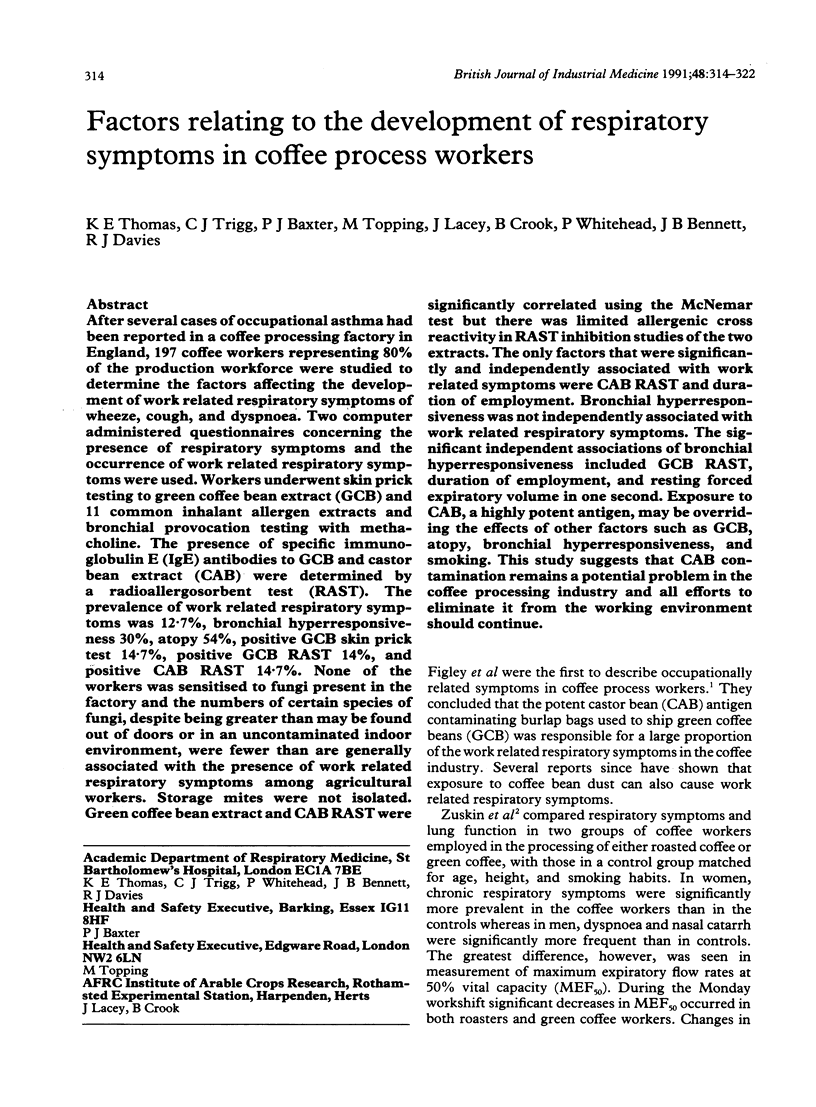
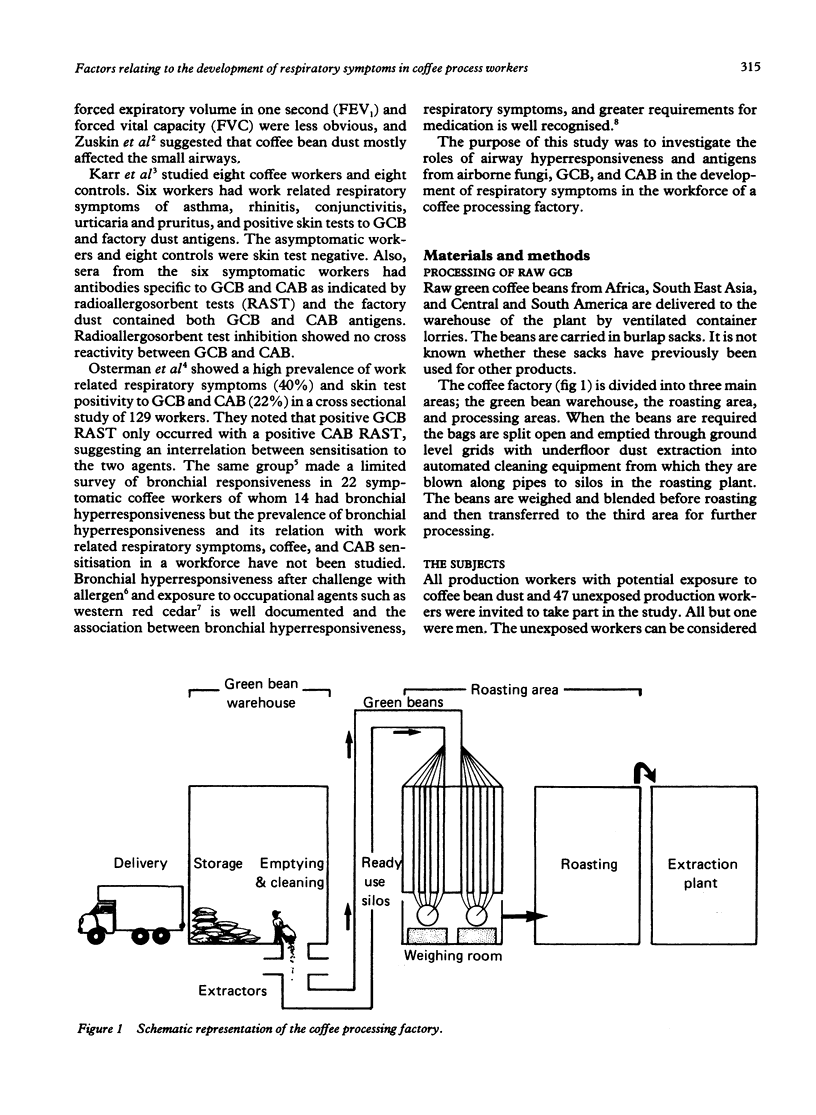
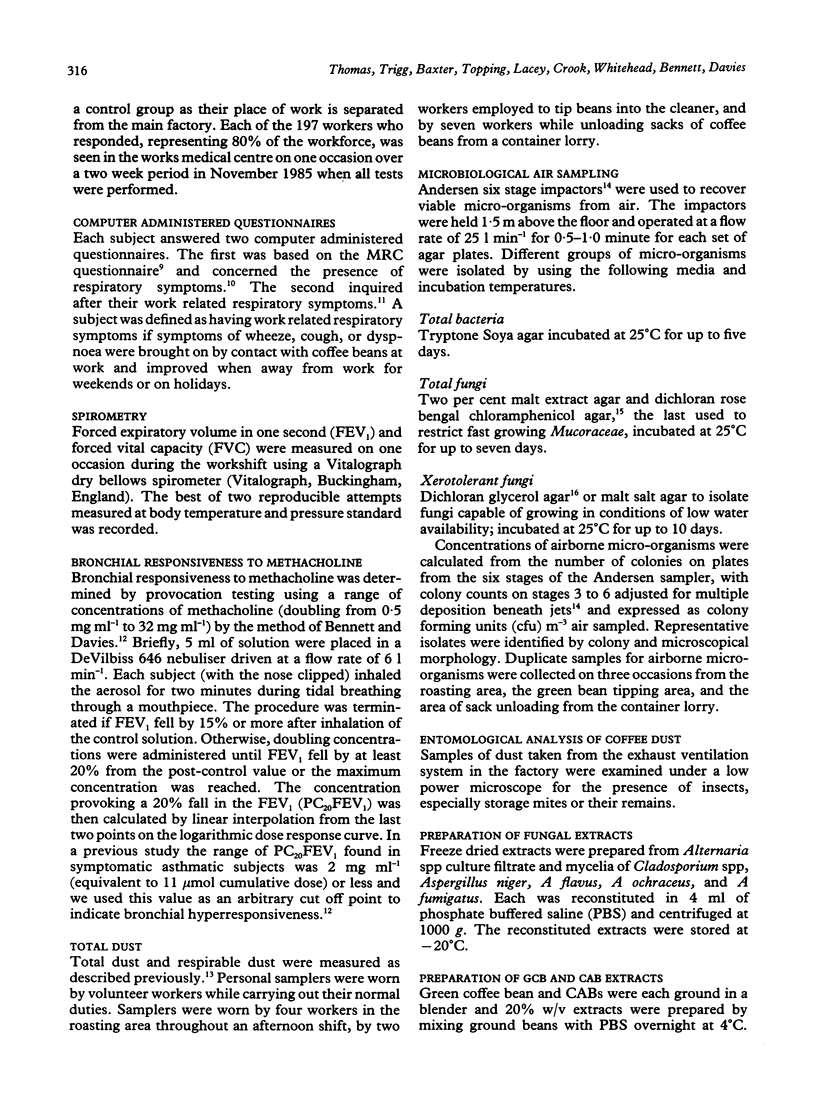
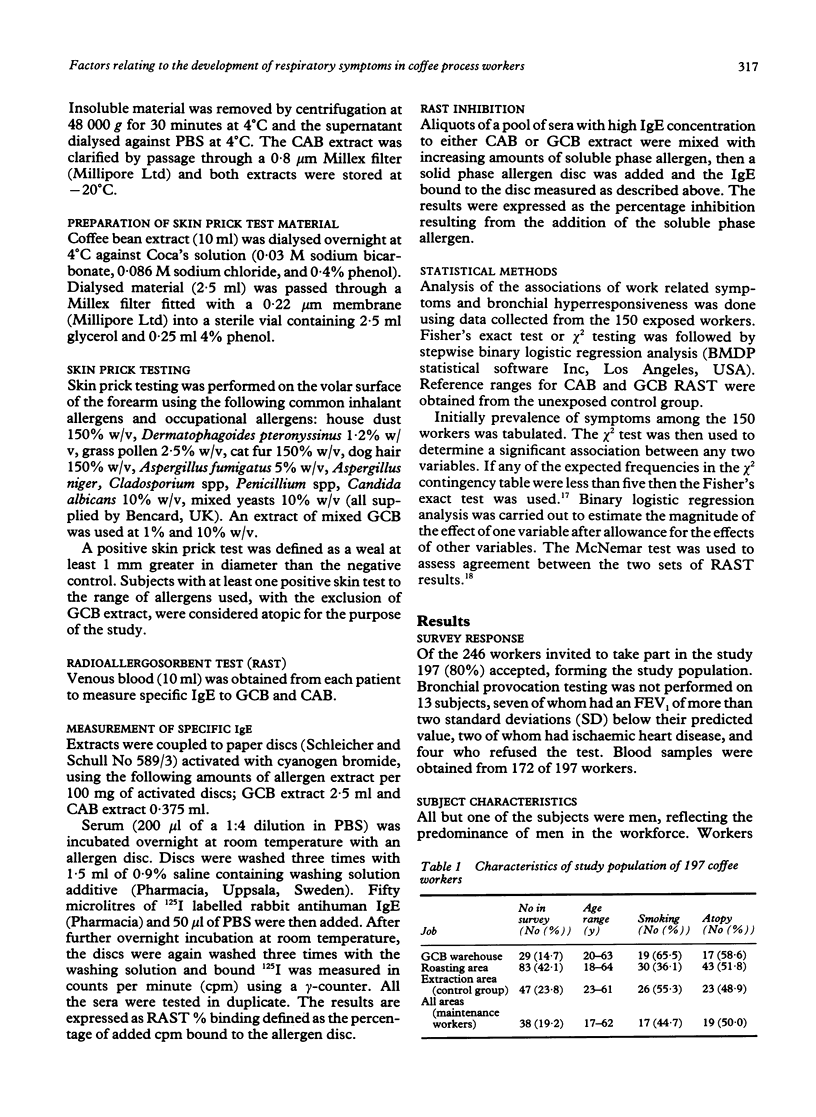
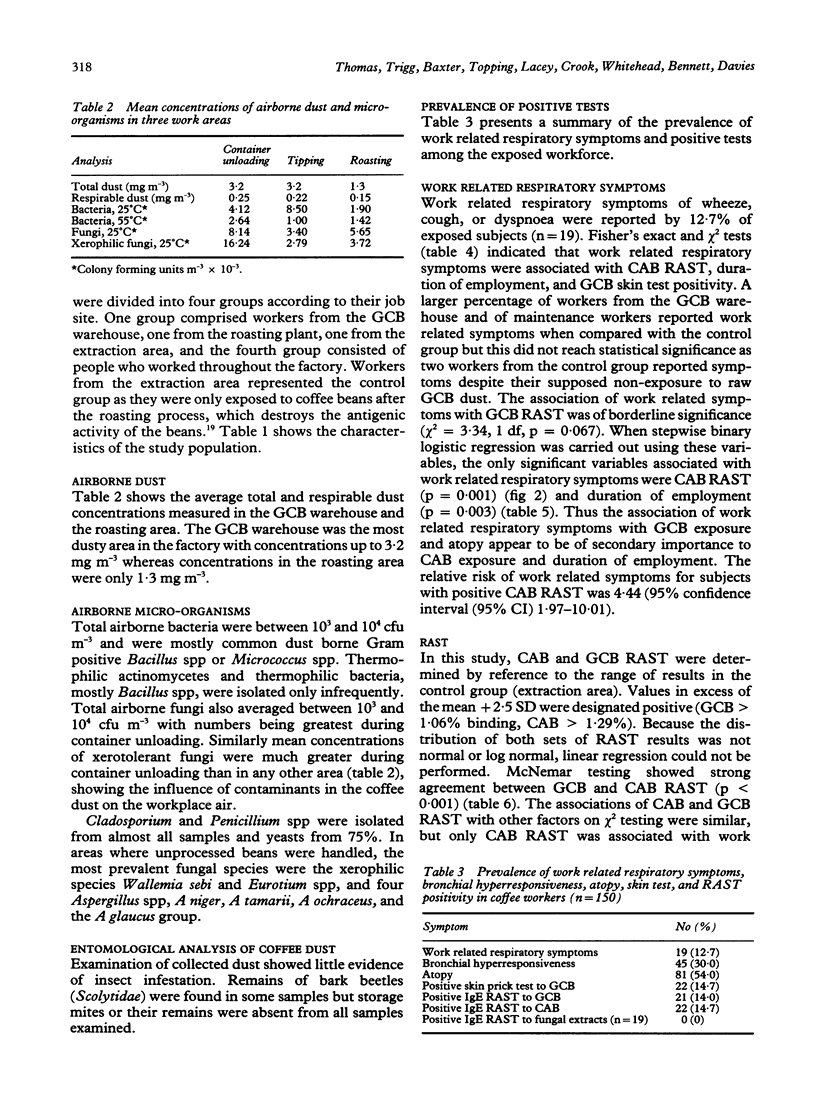
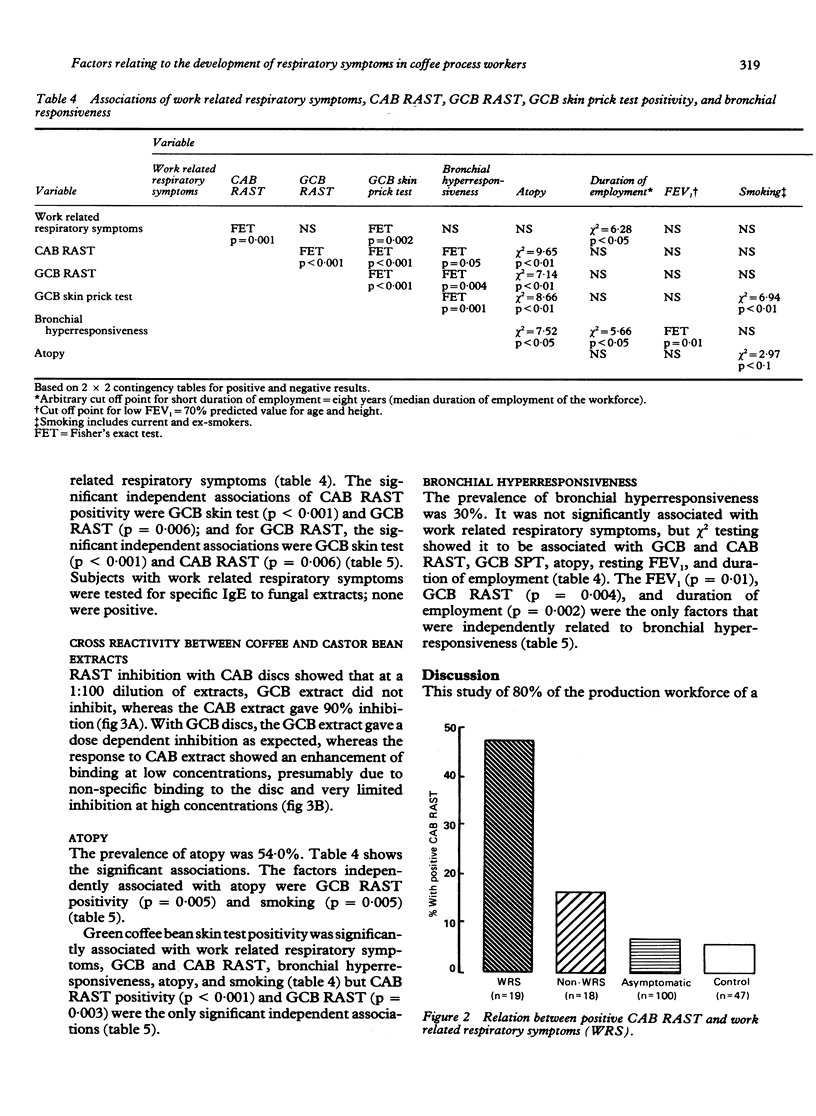
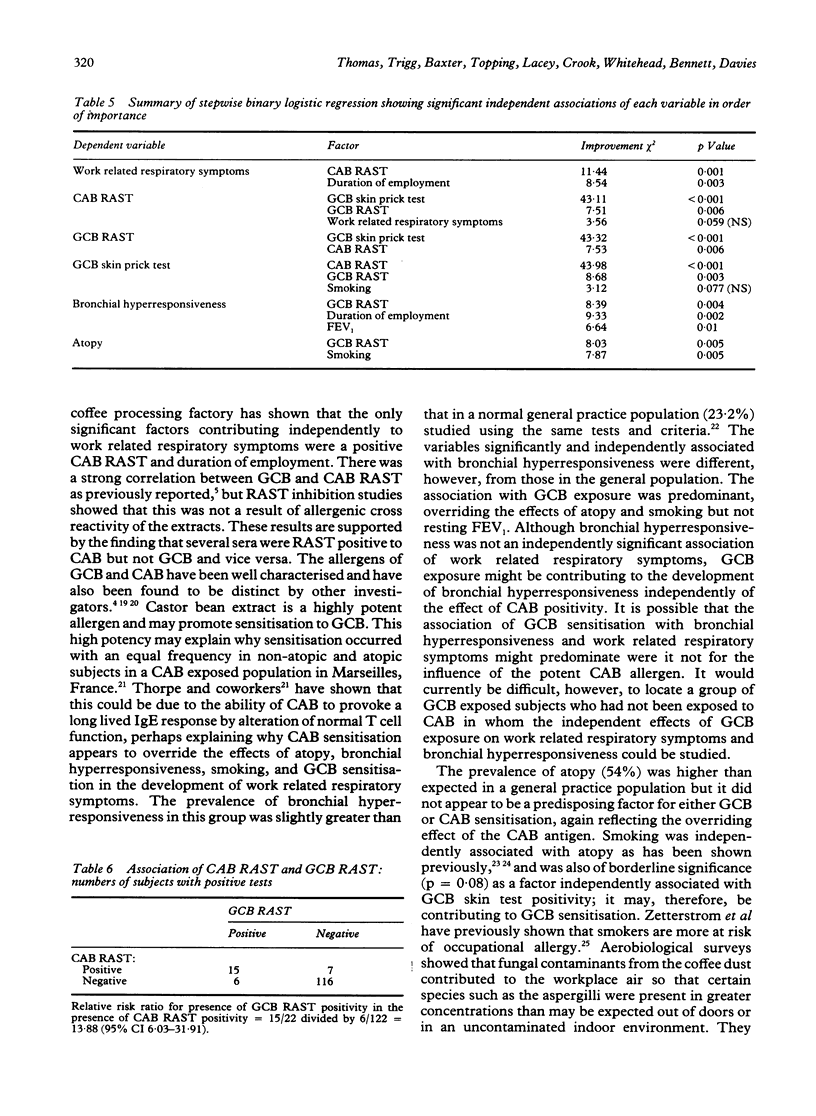

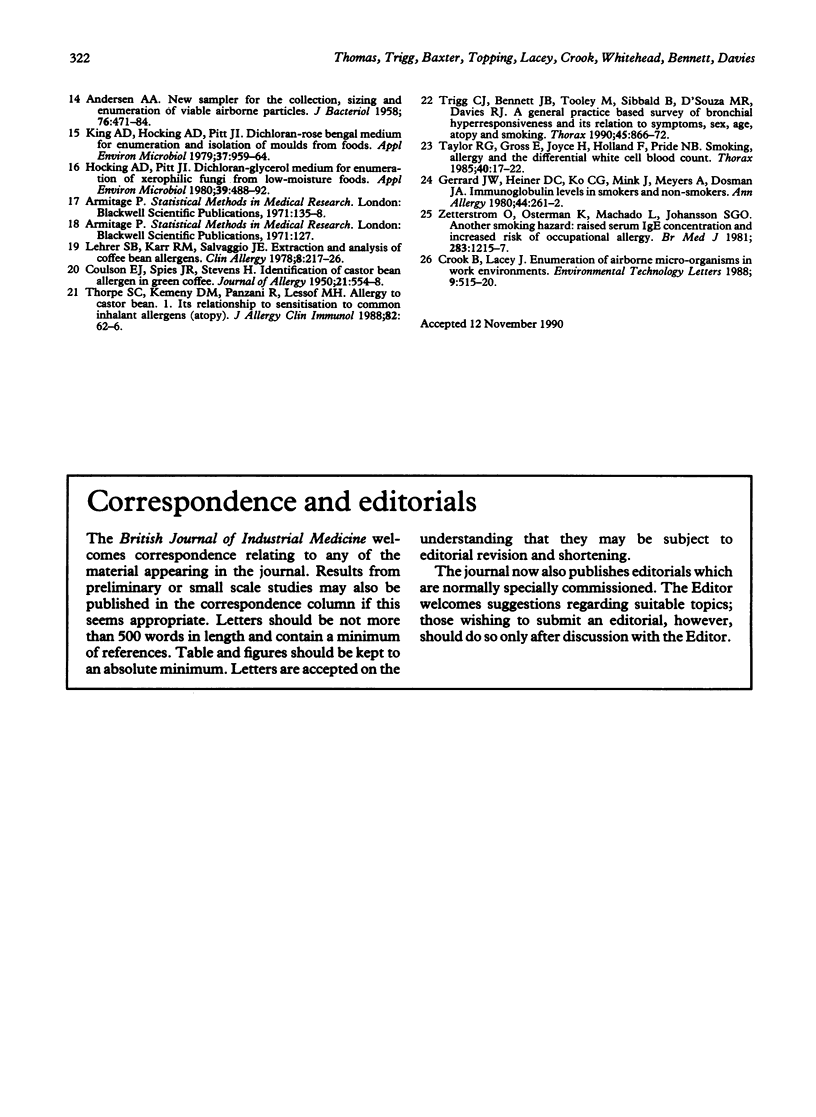
Selected References
These references are in PubMed. This may not be the complete list of references from this article.
- ANDERSEN A. A. New sampler for the collection, sizing, and enumeration of viable airborne particles. J Bacteriol. 1958 Nov;76(5):471–484. doi: 10.1128/jb.76.5.471-484.1958. [DOI] [PMC free article] [PubMed] [Google Scholar]
- Bennett J. B., Davies R. J. A comparison of histamine and methacholine bronchial challenges using the DeVilbiss 646 nebulizer and the Rosenthal-French dosimeter. Br J Dis Chest. 1987 Jul;81(3):252–259. doi: 10.1016/0007-0971(87)90158-6. [DOI] [PubMed] [Google Scholar]
- Bennett J., Osman J., Blainey A. D., Davies R. J. The assessment of a computer administered questionnaire in the differential diagnosis of asthma and chronic airflow limitation. Br J Dis Chest. 1988 Jul;82(3):268–273. doi: 10.1016/0007-0971(88)90067-8. [DOI] [PubMed] [Google Scholar]
- Blainey A. D., Topping M. D., Ollier S., Davies R. J. Respiratory symptoms in arable farmworkers: role of storage mites. Thorax. 1988 Sep;43(9):697–702. doi: 10.1136/thx.43.9.697. [DOI] [PMC free article] [PubMed] [Google Scholar]
- COULSON E. J., SPIES J. R., STEVENS H. Identification of castor bean allergen in green coffee. J Allergy. 1950 Nov;21(6):554–558. doi: 10.1016/0021-8707(50)90107-9. [DOI] [PubMed] [Google Scholar]
- Cockcroft D. W., Cotton D. J., Mink J. T. Nonspecific bronchial hyperreactivity after exposure to Western Red Cedar. Am Rev Respir Dis. 1979 Mar;119(3):505–510. doi: 10.1164/arrd.1979.119.3.505. [DOI] [PubMed] [Google Scholar]
- Cockcroft D. W., Ruffin R. E., Dolovich J., Hargreave F. E. Allergen-induced increase in non-allergic bronchial reactivity. Clin Allergy. 1977 Nov;7(6):503–513. doi: 10.1111/j.1365-2222.1977.tb01481.x. [DOI] [PubMed] [Google Scholar]
- FIGLEY K. D., RAWLING F. F. A. Castor bean: an industrial hazard as a contaminant of green coffee dust and used burlap bags. J Allergy. 1950 Nov;21(6):545–553. doi: 10.1016/0021-8707(50)90106-7. [DOI] [PubMed] [Google Scholar]
- Gerrard J. W., Heiner D. C., Ko C. G., Mink J., Meyers A., Dosman J. A. Immunoglobulin levels in smokers and non-smokers. Ann Allergy. 1980 May;44(5):261–262. [PubMed] [Google Scholar]
- Hocking A. D., Pitt J. I. Dichloran-glycerol medium for enumeration of xerophilic fungi from low-moisture foods. Appl Environ Microbiol. 1980 Mar;39(3):488–492. doi: 10.1128/aem.39.3.488-492.1980. [DOI] [PMC free article] [PubMed] [Google Scholar]
- Juniper E. F., Frith P. A., Hargreave F. E. Airway responsiveness to histamine and methacholine: relationship to minimum treatment to control symptoms of asthma. Thorax. 1981 Aug;36(8):575–579. doi: 10.1136/thx.36.8.575. [DOI] [PMC free article] [PubMed] [Google Scholar]
- Karr R. M., Lehrer S. B., Butcher B. T., Salvaggio J. E. Coffee worker's asthma: a clinical appraisal using the radioallergosorbent test. J Allergy Clin Immunol. 1978 Sep;62(3):143–148. doi: 10.1016/0091-6749(78)90098-2. [DOI] [PubMed] [Google Scholar]
- King A. D., Jr, Hocking A. D., Pitt J. I. Dichloran-rose bengal medium for enumeration and isolation of molds from foods. Appl Environ Microbiol. 1979 May;37(5):959–964. doi: 10.1128/aem.37.5.959-964.1979. [DOI] [PMC free article] [PubMed] [Google Scholar]
- Lehrer S. B., Karr R. M., Salvaggio J. E. Extraction and analysis of coffee bean allergens. Clin Allergy. 1978 May;8(3):217–226. doi: 10.1111/j.1365-2222.1978.tb03217.x. [DOI] [PubMed] [Google Scholar]
- Martin A. M. Dependence of acoustic attenuation of hearing protectors on incident sound level. Br J Ind Med. 1979 Feb;36(1):1–14. doi: 10.1136/oem.36.1.1. [DOI] [PMC free article] [PubMed] [Google Scholar]
- Osterman K., Johansson S. G., Zetterström O. Diagnostic tests in allergy to green coffee. Allergy. 1985 Jul;40(5):336–343. doi: 10.1111/j.1398-9995.1985.tb00244.x. [DOI] [PubMed] [Google Scholar]
- Osterman K., Zetterström O., Johansson S. G. Coffee worker's allergy. Allergy. 1982 Jul;37(5):313–322. doi: 10.1111/j.1398-9995.1982.tb01917.x. [DOI] [PubMed] [Google Scholar]
- Taylor R. G., Gross E., Joyce H., Holland F., Pride N. B. Smoking, allergy, and the differential white blood cell count. Thorax. 1985 Jan;40(1):17–22. doi: 10.1136/thx.40.1.17. [DOI] [PMC free article] [PubMed] [Google Scholar]
- Thorpe S. C., Kemeny D. M., Panzani R., Lessof M. H. Allergy to castor bean. I. Its relationship to sensitization to common inhalant allergens (atopy). J Allergy Clin Immunol. 1988 Jul;82(1):62–66. doi: 10.1016/0091-6749(88)90052-8. [DOI] [PubMed] [Google Scholar]
- Trigg C. J., Bennett J. B., Tooley M., Sibbald B., D'Souza M. F., Davies R. J. A general practice based survey of bronchial hyperresponsiveness and its relation to symptoms, sex, age, atopy, and smoking. Thorax. 1990 Nov;45(11):866–872. doi: 10.1136/thx.45.11.866. [DOI] [PMC free article] [PubMed] [Google Scholar]
- Zetterström O., Osterman K., Machado L., Johansson S. G. Another smoking hazard: raised serum IgE concentration and increased risk of occupational allergy. Br Med J (Clin Res Ed) 1981 Nov 7;283(6301):1215–1217. doi: 10.1136/bmj.283.6301.1215. [DOI] [PMC free article] [PubMed] [Google Scholar]


